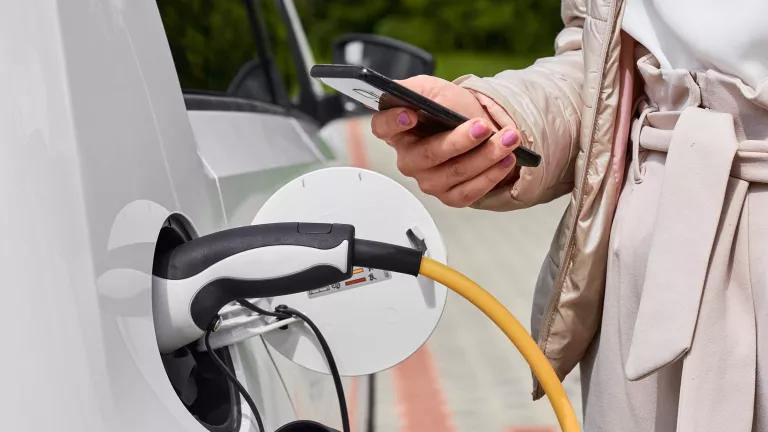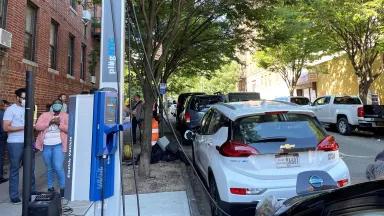Electric Vehicle Charging Explained
From charging stations to charging equipment, here’s everything you need to know.

Charging an electric car at a public charging station
Buying an electric vehicle (EV) means being able to skip expensive trips to the pump while protecting our climate and health. But there’s still a learning curve when it comes to charging, from how long it takes to how much it costs. Let’s break down your most pressing questions about EV charging so that you can drive and refuel confidently.
How long does it take to charge an electric car?
Charging your EV from empty can take as little as 20 minutes or upwards of 40 hours, depending on everything from the size of your particular car’s battery to where and when you decide to charge. First, it’s good to know the three levels of charging for EVs.
- Level 1: This is EV-speak for plugging the cord set that comes with your EV into a regular 120-volt outlet (the same kind you’d use for, say, a phone charger or a lamp). The gist is that this level of charging is slow—between 40 and 50 hours, if you’re charging from empty. Though it’s worth noting that, on average, U.S. car owners only drive about 31 miles a day. So Level 1 may be enough for your daily needs or in a pinch to add some mileage.
- Level 2: This means you’re charging from a 220-volt outlet (the same kind that heavy-duty appliances like washers use) or hardwired equipment. In this scenario, you can charge from empty in about four to ten hours. Public Level 2 charging stations are common at locations where drivers tend to park, like workplaces or commercial parking lots, but most EV owners also get this version installed in their garage so they can charge overnight. A nice bonus: Some incentives could cover the cost of Level 2 equipment.
- Level 3: For the fastest charging speeds, you can turn to Level 3 chargers—also known as DCFC chargers or direct current fast chargers—which can charge your EV from empty in as little as 20 minutes. These public charging stations are more expensive to use, but they are particularly great for time-conscious road-trippers or urban drivers who can’t easily refuel at home. Plus, they’re getting faster. The first generation typically charged vehicles at 50kW, but the ones being installed today are generally at least three times as powerful, with some charging at 350kW.

Overall, there are a few other things to keep in mind. One, you’ll rarely charge your battery from completely empty to completely full. EV drivers are far more likely to “top off” their battery—making charging times quicker in practice. (In general, most manufacturers suggest keeping the battery’s charge in the range of 20 to 80 percent to extend its life.)
And, of course, not every car has the same battery capacity. General Motors’ 2022 all-electric Hummer, with its massive 212 kWh battery, could take hours longer to fully charge than the Chevy Bolt’s more modest 65-kWh battery. That said, Level 2 charging can generally charge even the biggest EV batteries overnight.
Additionally, not every battery can accept electricity at the same rate, a limitation that’s most relevant when it comes to Level 3 charging. The first generation of EVs was often only capable of charging at 50kW, so they cannot take advantage of the 350kW Level 3 charging stations that are increasingly the industry standard and which can provide hundreds of miles of range in about as much time as it takes to get a coffee and use the restroom.
What are the different types of EV plugs?
EVs have distinct charge ports, which are like outlets on the car. This means that the shape of the plug you connect to your EV varies as well. It’s important to know what plug your car uses, as not every public charging station will be compatible with every kind of plug.
For Level 1 and Level 2 charging, all EVs sold in the United States (besides Teslas) use a J1772 plug (also known as a J-plug). For speedy Level 3 DCFC, all U.S. EVs (again, besides Teslas) use either CCS (which stands for “combined charging system” and is the most common) or CHAdeMO plugs, depending on the brand of car. Teslas use the same proprietary plug for all levels of charging—including at Tesla Supercharger stations. They also come standard with a J1772 adapter.

How much does it cost to charge an electric car?
The average EV driver will spend 60 percent less on fueling costs compared to the average gas vehicle in their class. But electricity still isn’t free, and you’ll have to do a little math to determine what charging will run you.
Most EV owners regularly charge at home, which means the cost of electricity where you live and when you charge your car will determine your bill. To get a rough estimate of your monthly charging costs at home, multiply your car’s kilowatt-hour (kWh)/100 miles rate (the EV equivalent of miles per gallon) by your electricity rate, which you can find on your utility bill. This will give you the electricity cost per 100 miles driven.
Note that charging your car overnight, when electricity demand and price drop, can save you as much as 30 percent. If you forgo charging at home and go with public charging stations, particularly the ultra-speedy DC fast chargers, you’ll be paying a premium.
But if you want to skip the math, know this: Charging at home is roughly the equivalent of fueling up on a dollar-a-gallon gasoline, according to NRDC senior attorney Max Baumhefner.
Where are the electric vehicle charging stations near me?
EV charging stations aren’t as ubiquitous as gas stations—but that’s likely to change. Encouragingly, the Bipartisan Infrastructure Law dedicated $7.5 billion to build out half a million more public charging stations. Plus, as the market share of EVs grows, expect local governments, utilities, and private electric vehicle charging companies like ChargePoint and Tesla to build out their networks too. But even now, there’s a good chance you can find at least a few public chargers near you.
You can use a public charging station app—like ChargeHub, PlugShare, or Chargemap—to filter nearby locations by available plug type.
Keep in mind that some charging companies require you to have a membership to recharge your EV at their stations, which means you may need a physical membership card or to log in with your phone. If you drive a Tesla, the car’s navigation points you to their proprietary network of Superchargers, which only Tesla drivers can visit (at least for now).
Are electric vehicles worth it?
Rest assured that choosing to drive an EV—and learning how to charge it—is well worth your time: The average EV consumer saves thousands of dollars across the life of the car, spares the community toxic tailpipe emissions, and helps us ditch climate-destroying fossil fuels for good.
This NRDC.org story is available for online republication by news media outlets or nonprofits under these conditions: The writer(s) must be credited with a byline; you must note prominently that the story was originally published by NRDC.org and link to the original; the story cannot be edited (beyond simple things such as grammar); you can’t resell the story in any form or grant republishing rights to other outlets; you can’t republish our material wholesale or automatically—you need to select stories individually; you can’t republish the photos or graphics on our site without specific permission; you should drop us a note to let us know when you’ve used one of our stories.




How to Ditch the Biggest Fossil Fuel Offenders in Your Life
What Are the Solutions to Climate Change?
What Are the Causes of Climate Change?